Bullet Journal Page Ideas For Work
Bullet Journal page ideas are a dime a dozen, aren’t they? But finding ones that really hit the sweet spot of organizing your work life – now that’s the golden ticket! You’re in luck because we’re about to dive right into that.
Imagine having a magic wand that organizes your chaotic work life into neat, manageable bits. That’s what your Bullet Journal can be – your very own magic wand!
Today, we’ll explore how you can set up your Bullet Journal for work. And oh boy, do I have some juicy page ideas for you!
My goal is to help you create a versatile tool that won’t just survive but thrive in your work environment. So grab your journal, let’s roll up our sleeves and start creating your ultimate work companion!

Recommending Bullet Journal for work can be a bit tricky since we all have very different jobs with different needs.
So take these recommendations and ideas as a starting point, and you can use these to move your creativity and make pages that work exactly for your life and your work.
I know if you give it a try, it can make a huge impact on your work days and productivity.
So let’s dive in!
This post may contain affiliate links. They will be of no extra expense for you, but I receive a small credit. Please see my Disclosure for more details. Thank you for supporting Masha Plans!
Stationery Recommendations
Before we start talking about customizing your Bullet Journal, let’s talk about stationery. These days, there are so many different types and brands available that it’s easy to get overwhelmed.
So here are a few of my recommendations:
- A journal. Whether you decide to use a separate journal or plan in your current one, you’ll need a journal. There are many out there, you just need to choose one that fits you. I’ve been liking my Archer and Olive journals, and you can use code MASHA10 to get 10% OFF.
- Fineliners. A good set of fineliners is a staple of your Bullet Journal. My favorite is the Sakura Pigma Micron, and they come in different sizes, so you get a wide variety of line thicknesses.
- Highlighters. I find that highlighters are great for adding a bit of visual elements to your work pages, and my go-to is Zebra Mildliners.
- Small brush pen. These are great for drawing and, of course, for adding brush lettering to your pages. It’s a cute little element to add a bit of spark to your Bullet Journal. My favorites are Tombow Fudenosuke.
With all the supplies prepared, time to sit down in your home office, or maybe just at the kitchen table, or heck, maybe just do it in your office and start turning your Bullet Journal into a great helper it can be for your work goals.
Can I Use Bullet Journal For Work
Can you use Bullet Journal for work? This is probably the first question that pops into your mind, and the answer is a resounding yes! Not only is it possible, but it can also revolutionize your work life in ways you never imagined.
And there are so many benefits of actually creating Bullet Journal page ideas for work:
- Organization and Efficiency: the world of work is often fast-paced and demanding, leaving no room for disarray. One of the most significant advantages of a Bullet Journal is its ability to help you stay organized. By jotting down your tasks, responsibilities, and deadlines, you can enhance your efficiency and ward off any potential overwhelm or distractions. It’s like having your own personal assistant, ensuring you stay on top of your game at all times.
- Memory Aid: with so much going on at work, it’s easy to forget tasks or responsibilities. However, forgetting isn’t an option when your performance is on the line. This is where your Bullet Journal steps in as your second brain. It allows you to unload all the information swirling around in your head onto paper, reducing the mental clutter and stress of trying to remember everything.
- Documentation: a Bullet Journal isn’t just about listing tasks; it’s also a fantastic tool for documentation. Whether it’s noting down meeting minutes, tracking project progress, or even jotting down spontaneous ideas, your Bullet Journal can serve as a comprehensive record of your work life. This documentation can prove invaluable for reference, accountability, and even demonstrating your contributions during performance reviews.
In essence, a Bullet Journal isn’t just a notebook; it’s a productivity powerhouse that can transform your work experience. So why not give it a go and see the difference for yourself?
Should You Create A Separate Bullet Journal For Work
The decision to use your existing Bullet Journal for work or start a fresh one often raises questions among enthusiasts. The answer, however, is not set in stone and largely depends on your personal circumstances and how you utilize your Bullet Journal.
Speaking from my own experience as a business owner who works from home, I find that a single journal suffices for both my professional and personal needs.
Owning your own business often means the lines between work and personal life blur, making it convenient to manage everything from one place. However, this might not be the case for everyone.
If you’re employed in a corporate setting, you may prefer a clear division between your work and personal life. Having separate journals could help you achieve that work-life balance.
This way, when the weekend rolls around, you can close your work journal and focus solely on your personal commitments, free from the work-related distractions that might lurk within a combined journal.
Furthermore, maintaining a separate journal for work may prevent unnecessary distractions during your work hours. Imagine opening your journal to jot down meeting minutes and getting sidetracked by your personal plans, like scheduling your weekend around your child’s basketball game. A separate work journal can keep such distractions at bay.
That being said, there is no one-size-fits-all solution when it comes to Bullet Journals. What works for one person may not work for another.
So, I’d recommend experimenting with both approaches to see which one suits you best. Whichever route you choose, the key is to create pages that aid your productivity and ensure you utilize them effectively.
After all, the primary goal of a Bullet Journal is to make your life more organized and efficient.
How To Start A Bullet Journal For Work
Making the decision to start a separate Bullet Journal for work is the first step. Once you’ve made that choice, the setup process is very similar to your usual personal journal.
It involves creating a variety of pages designed to cater to your professional needs and responsibilities.
Start by setting up your new Bullet Journal in the same way you would set up your personal one. The structure and layout are essentially identical to your personal Bullet Journal.
The key difference lies in the content. Your work Bullet Journal should be tailored to reflect your professional life. This means customizing each page to align with your work responsibilities.
In addition to the basic pages, you might want to add some work-specific ones.
Let’s start by ways you can customize the core Bullet Journal pages so that they would work for your work goals.
Key And Index
Bullet journaling is a unique method of personal organization, and the essence of it lies in its simplicity and adaptability. Two of the fundamental elements that form the backbone of any bullet journal are the Bullet Journal key and the Bullet Journal index.
Both these elements play critical roles in your work Bullet Journal, much like they do in your personal journal, but with a more professional slant.
The Bullet Journal key is akin to a legend or a guide that helps you decipher the symbols and notations used throughout your journal. It’s like a secret code that only you understand, which makes your journal both personal and efficient.
In the context of a work Bullet Journal, you can customize this key to include special work-related symbols. For example, you may choose to represent a meeting with a specific icon or use a particular color to denote a looming deadline. These symbols aid in rapid logging and help you stay organized at work.

The Bullet Journal index, on the other hand, is essentially your table of contents. It provides an easy and quick way to find any information inside your journal. This could be anything from a note about a client meeting to a task list for a specific project.
In the professional sphere, the index becomes all the more vital. Given the multitude of tasks, projects, and deadlines you’re likely juggling at work, having a detailed and well-maintained index ensures you can locate any piece of information when you need it. You might even want to consider categorizing your index based on different projects or clients for easier access.
While these elements – the key and the index – form the basic structure of your work Bullet Journal, the beauty of this system lies in its flexibility. You can tweak and tailor these elements to suit your unique professional needs. For instance, if you’re in a creative role, you might want to include symbols for brainstorming sessions or design approvals in your key. Similarly, if you’re in a managerial position, your index might have sections dedicated to team meetings or performance reviews.
Future Log
The Bullet Journal future log is an essential part of any Bullet Journal, acting as a hub for planning and organizing your long-term goals, deadlines, and events.
In a professional context, the future log takes on even more significance, serving as a roadmap for your career trajectory and work obligations.
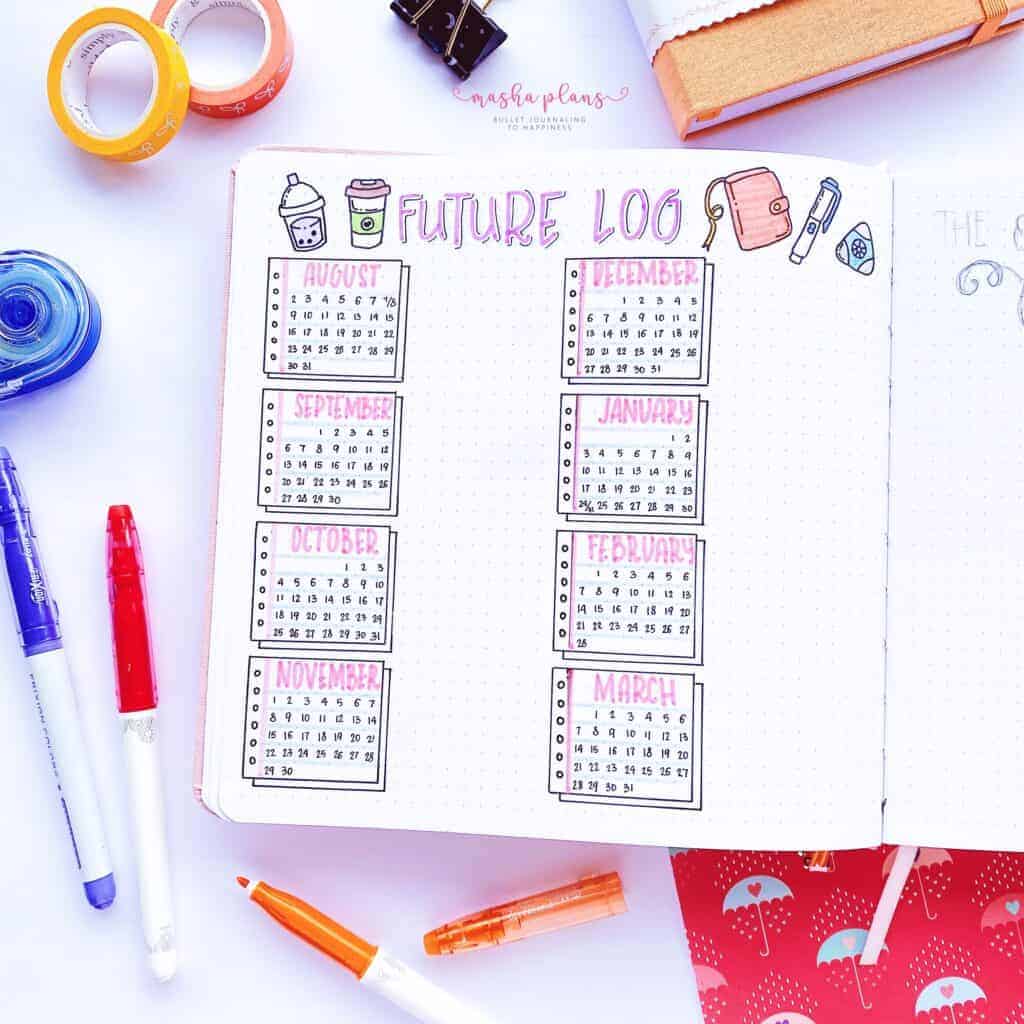
Here’s a more detailed exploration of how you can make the most of it:
- Future Planning: The future log is perfect for mapping out your professional future. You can use it to jot down any impending deadlines, schedule future meetings, note upcoming professional conferences, or even plan for performance reviews. By having all these important dates and events in one place, you can be better prepared and ensure nothing slips through the cracks.
- Work Travel Organizer: If your job often requires you to travel, the future log can serve as an invaluable tool. It can act as a central repository for all your travel-related information. Flight timings, hotel bookings, meeting locations, and even local attractions worth visiting – all of this can be organized neatly within your future log. This way, not only do you have all your work-related information at your fingertips, but you also have a handy resource for making the most of your travels.
- Networking and Events: The future log is also ideal for keeping track of networking events and professional development opportunities. Whether it’s an industry conference, a seminar, or a casual meet-up, noting these in your future log ensures you never miss an opportunity to grow professionally.
A future log can be a comprehensive tool for career planning, work organization, and professional development. By utilizing it effectively, you can stay on top of your work commitments, plan for your career growth, and even make your work travels more enjoyable and efficient.
Monthly Log
The Bullet Journal monthly log is a fundamental component of the Bullet Journal system, providing a clear and concise overview of your month. This monthly snapshot allows you to plan ahead, set goals, and keep track of important events.
In a professional context, the monthly log can become an even more powerful tool, acting as a comprehensive dashboard for your work-related activities.

Here’s how you can maximize its potential:
- Deadlines and Milestones: The monthly log is an ideal place to record all your upcoming deadlines and project milestones. Whether it’s a report due at the end of the month or a product launch scheduled for the third week, noting these in your monthly log helps ensure that nothing falls through the cracks.
- Monthly Goals: Your monthly log can also serve as a platform for setting and tracking your professional goals. You might want to set specific targets like closing a certain number of sales, improving a skill, or finishing a project. By recording these goals in your monthly log, you’ll have a constant reminder of what you’re aiming for, helping you stay focused and motivated throughout the month.
- Team Meetings and Events: If you work in a team setting, the monthly log can help you keep track of team meetings and events. From regular weekly catch-ups to special brainstorming sessions, noting these down in your monthly log ensures you’re always prepared and never double-book yourself.
- Work-Related Tasks and Events: Beyond the usual meetings and deadlines, there are likely many other work-related tasks and events that you need to keep track of. These could include performance reviews, training sessions, client calls, or industry conferences. By adding these to your monthly log, you’ll have a comprehensive view of your professional commitments.
- Reflection and Review: At the end of each month, you can use your monthly log as a tool for reflection and review. Look back at what you’ve achieved, where you fell short, and how you can improve in the next month. This practice can help you continuously grow and evolve as a professional.
The Bullet Journal monthly log isn’t merely a calendar of your work activities. It’s a multi-functional tool that aids in planning, goal-setting, task management, and self-improvement. By adding work-related events and tasks to your monthly log, you can create a personalized work planner that keeps you organized and drives you towards your professional goals.
Weekly / Daily Log
The Bullet Journal system, with its innovative and adaptable structure, truly shines when it comes to day-to-day planning. The weekly log, or the daily Bullet Journal spread, is where this planning comes to life.
Although similar in structure to the one used in your personal Bullet Journal, the work version of the weekly log or daily spread takes on a distinct flavor, concentrating more on professional tasks and obligations.
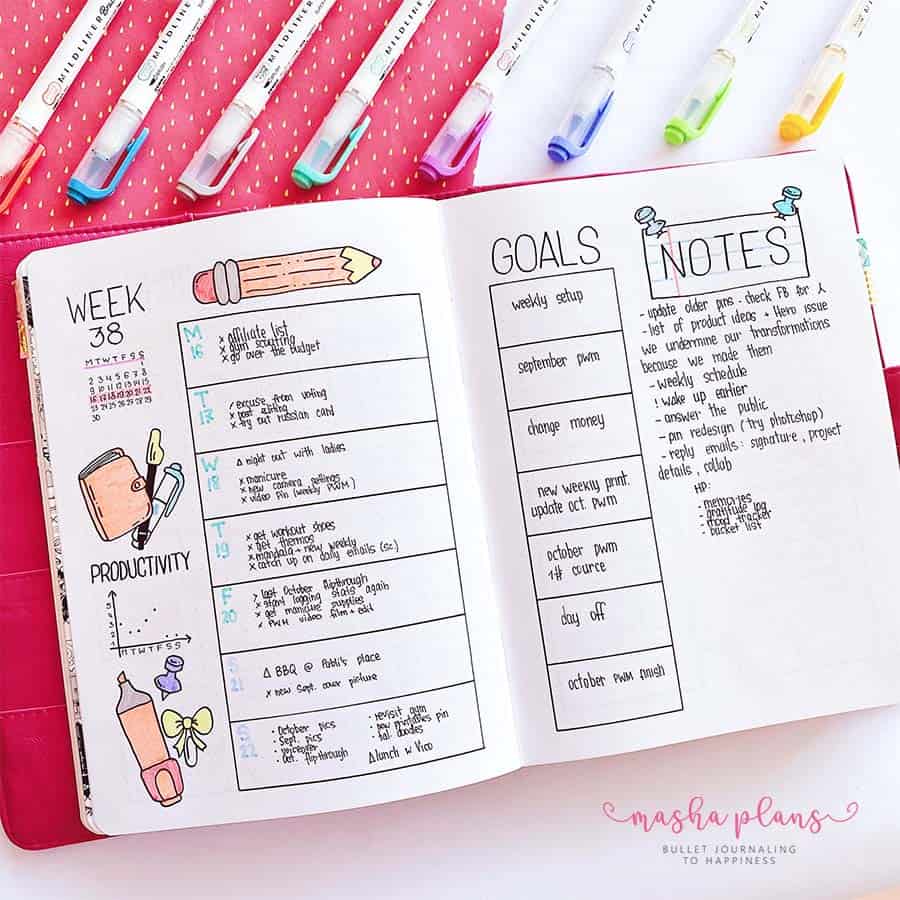
The essence of the weekly log or daily spread lies in its ability to break down your larger goals into manageable daily tasks. It allows you to plan and prioritize your work on a day-to-day basis, ensuring that you stay focused and productive. Whether it’s a meeting with a client, a project deadline, or a team brainstorming session, noting these down in your daily spread ensures that you’re always prepared for what’s ahead.
Unlike your personal Bullet Journal, where you might include elements like habit trackers, journaling prompts, or artistic doodles, your work Bullet Journal will likely be more streamlined and focused. It’s filled predominantly with work-related content – tasks, deadlines, meetings, and professional goals. This focus on professional content ensures that your work Bullet Journal stays relevant and useful in aiding your productivity at work.
The key to making the transition from a personal to a work Bullet Journal lies in shifting your focus. Many of the pages and spreads will be the same, but the content will be more work-oriented. By switching your focus to work-related tasks and goals, you can transform your Bullet Journal into an effective tool for managing your professional life.
Of course, there are some more specific pages, so let’s look into that.
Bullet Journal Page Ideas For Work
Let's get specific! Here are some exact pages you can use for work.
Some of these might be pages generally for productivity, but of course, you do need to make sure you're being organized and productive when it comes to your work.
Starting strong with a brain dump is an excellent practice, particularly when it comes to managing work-related stress and tasks.
A brain dump is essentially a process of transferring all of your thoughts, ideas, worries, and tasks from your mind onto paper. It's an incredibly useful tool for decluttering your mind, gaining clarity, and reducing feelings of overwhelm.
In essence, starting with a brain dump is not just a method of offloading thoughts and tasks; it's a powerful strategy for stress management, task organization, idea generation, and effective planning. By incorporating this practice into your work routine, you can enhance your productivity, creativity, and overall well-being.
Click "read more" to learn more about using a brain dump.
A page dedicated to tracking your work schedule can be an essential component of your Bullet Journal or planner, particularly if you have a job with irregular or fluctuating hours.
This kind of page serves as a visual representation of your work commitments, providing an at-a-glance overview that helps you manage your time effectively and maintain a healthy work-life balance.
A dedicated work schedule page in your Bullet Journal or planner, particularly when enhanced with a color-coding system, can be a powerful tool for managing irregular work hours. It can help you stay on track with your commitments, improve your time management, maintain a healthy work-life balance, and even boost your cognitive processing.
Well, this is more like something to add to your existing weekly spread rather than a separate page idea.
Planning your time at work hour by hour is very useful, so you get a better idea of how long it takes you to do things and how you actually spend your time at work. Maybe you'll see that some things can be delegated, so you free up time for more important responsibilities.
I had to add a generic name to this spread because it actually has so much information in it.
Meetings, tasks, and general notes. I also really like the fact that there is this area with the project's progress bar. I'm always up for some visual representation of things.
This is another way to stay productive with your Bullet Journal. It basically helps you to work on tasks in a more concentrated way, without any distractions. So eventually, you complete your projects faster and with better quality.
In two words, this is how it works: you do one pomodoro (25 min intervals) of concentrated work, then take 5 min off. After several pomodoro you can take a longer break, like 15 minutes.
This tracker will help you evaluate how much work you did and how productive was your work day.
This is a fantastic way to organize your projects. Use little sticky notes to see how your projects are moving along.
It's a great way to visually represent how far along you are with your projects and what else you need to create.
Regarding project management, I recommend you check the guest post from Mark at @mark.your.pages. He uses his journal for work so he's a pro when it comes to work Bullet Journal page recommendations.
Click "read more" to see some other pages and ways he recommends using your journal for project management.
The next time you're preparing for a new month, consider incorporating an additional page into your Bullet Journal or planner. This page can serve as a comprehensive hub for all your monthly projects, providing a clear and concise overview of the work that lies ahead.
Incorporating a monthly focus page into your Bullet Journal or planner setup is not just about organization; it's about gaining clarity, improving productivity, managing stress, and learning from past experiences.
By providing a clear overview of your tasks and projects, this page can help you navigate your work more efficiently and effectively.
A mind map is a great way to brainstorm ideas and plan out projects. It can also be a fun visual representation of duties for everyone on your team.
Be sure to click "read more" to learn more about this technique and how it can help you, both in work and in your personal life.
Free Bullet Journal Printables
Of course, I wouldn’t leave you hanging without a freebie. I’m leaving you with a project management page inspired by Mark from @mark.your.pages.
You can already find this page in the Resources Vault.
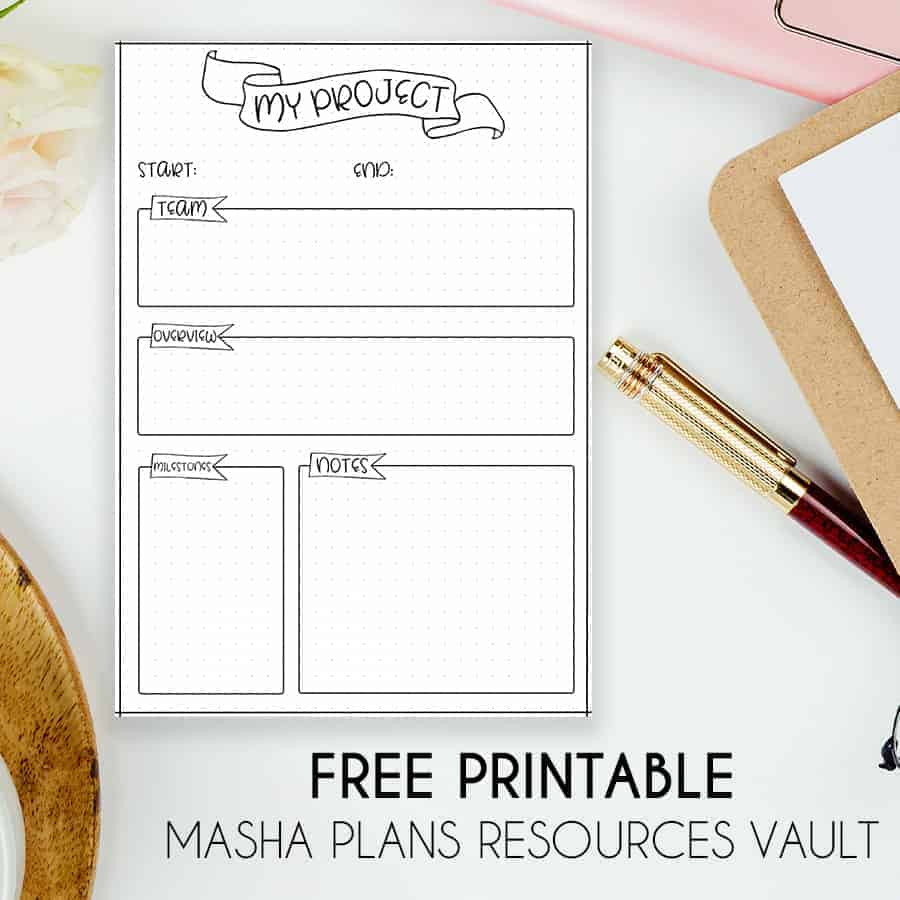
If you don’t have access yet, you can always sign up in the form below.
Once you confirm your subscription, you’ll get the password to get 50+ free Bullet Journal printables, stickers, and worksheets to use right away.
If you’ve never used printables before, be sure to check my post How To Use Printables In Your Bullet Journal.
It’s pretty basic, and you can find all the supplies you need in my post Supplies For Using Bullet Journal Printables.
More Resources
There are many more ideas out there to help you with pretty much anything you can think of.
So here are a few posts for you to check next:
- Project Management In Your Bullet Journal
- 9 Simple Ways To Stay Productive While Working From Home
- Bullet Journal Brain Dump To Clear Up Your Mind
>>> Are you planning to add these to your everyday Bullet Journal or start a whole new journal just for work? Share with us in the comments.





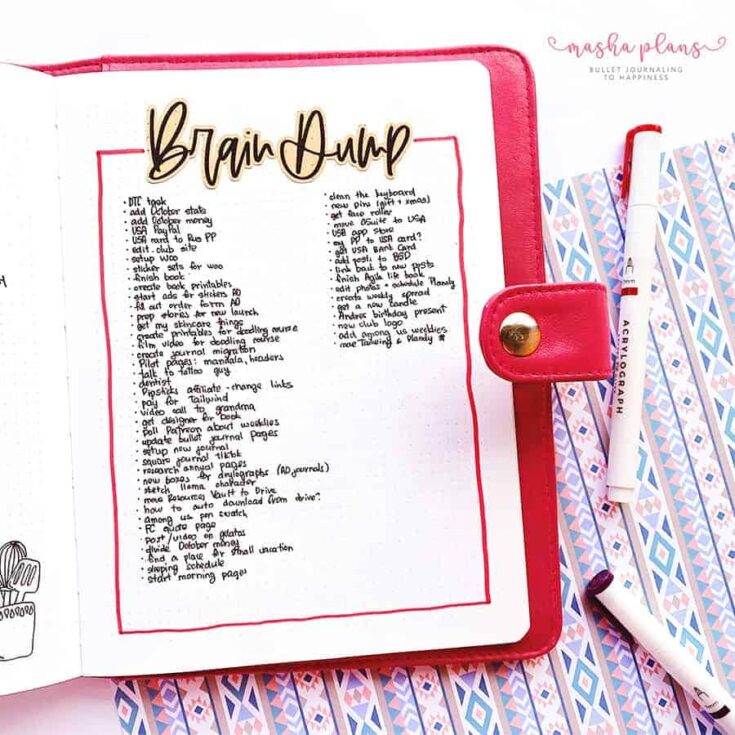
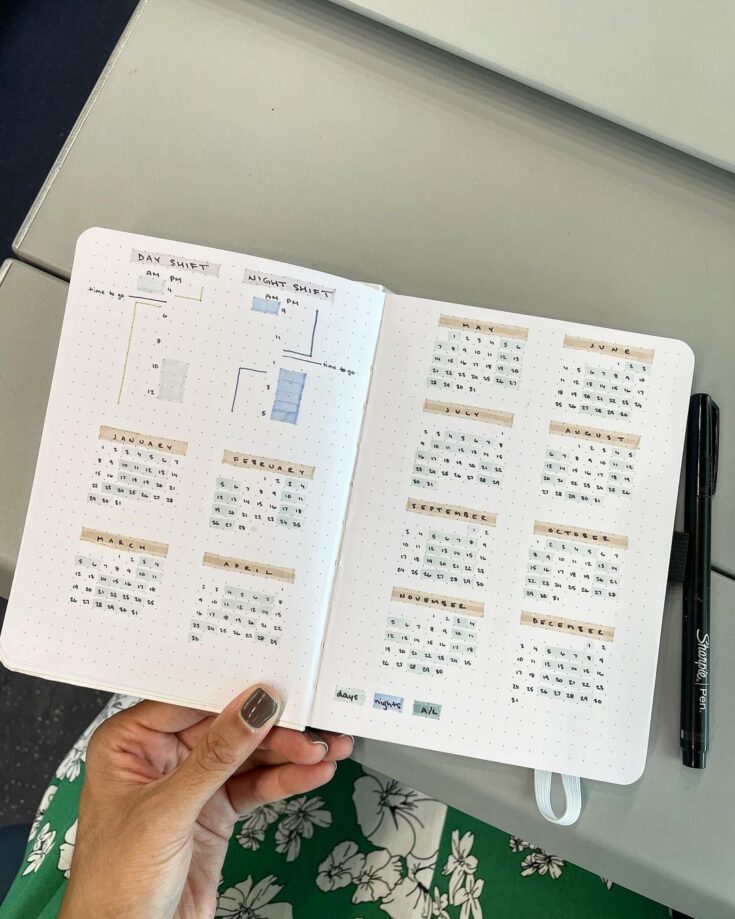
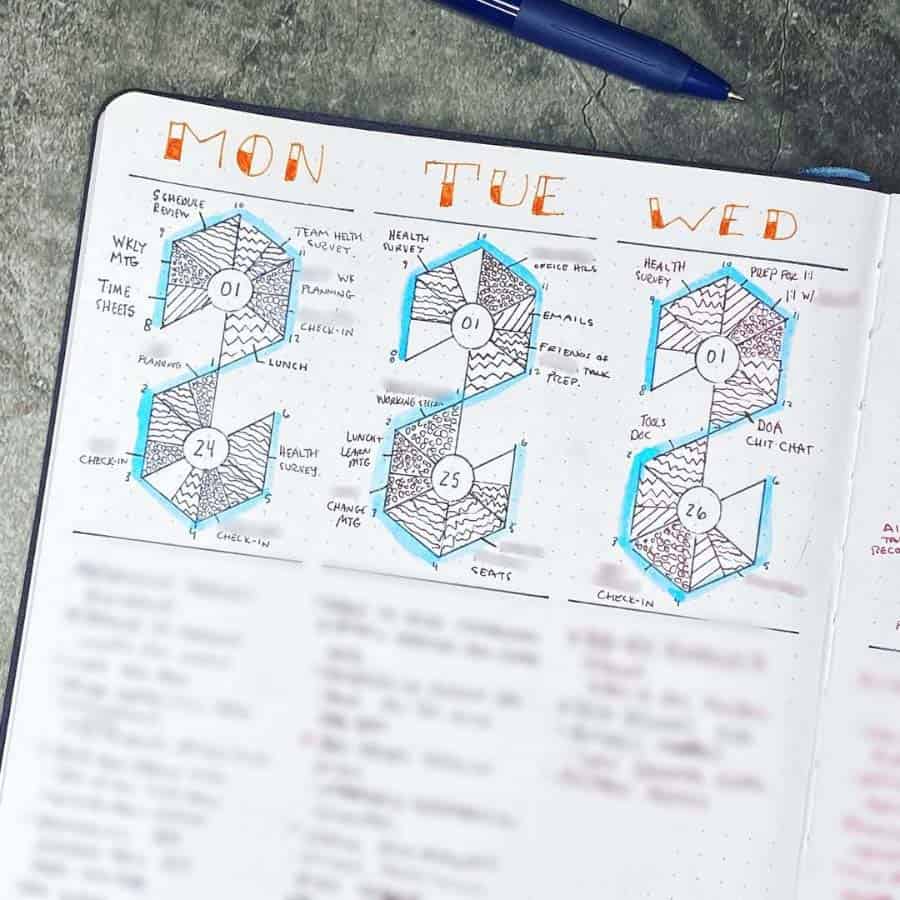
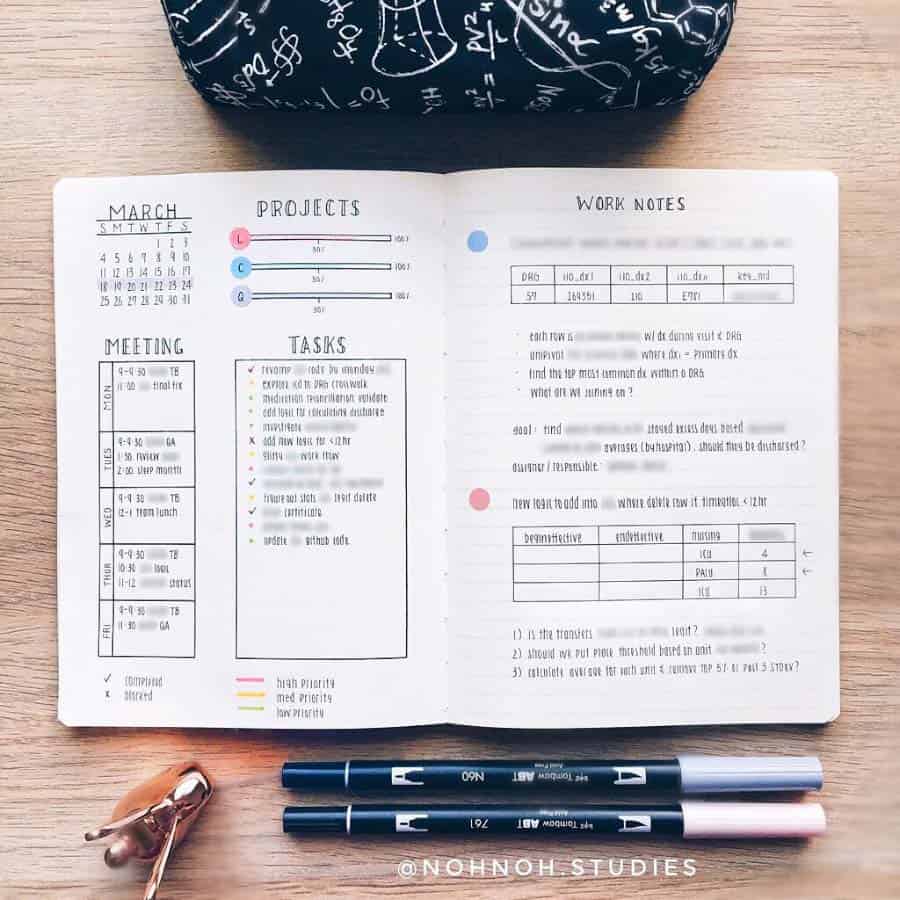
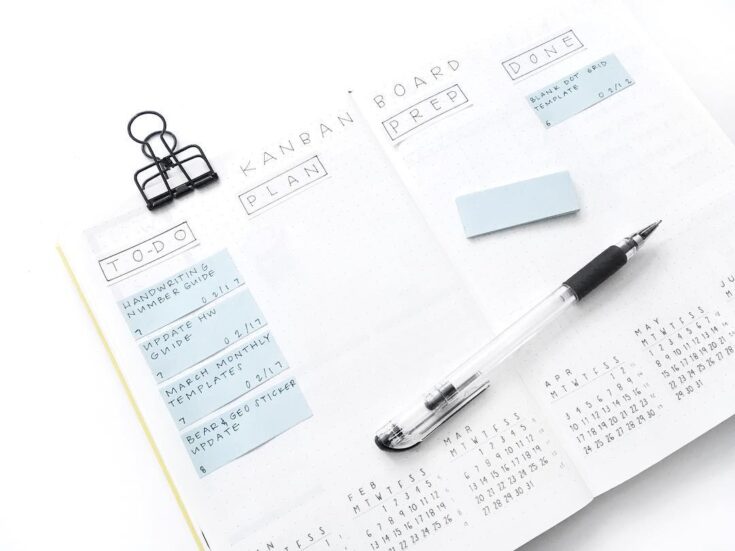
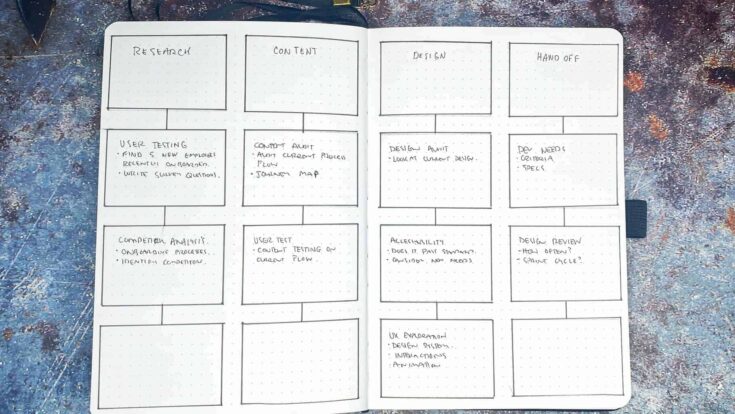

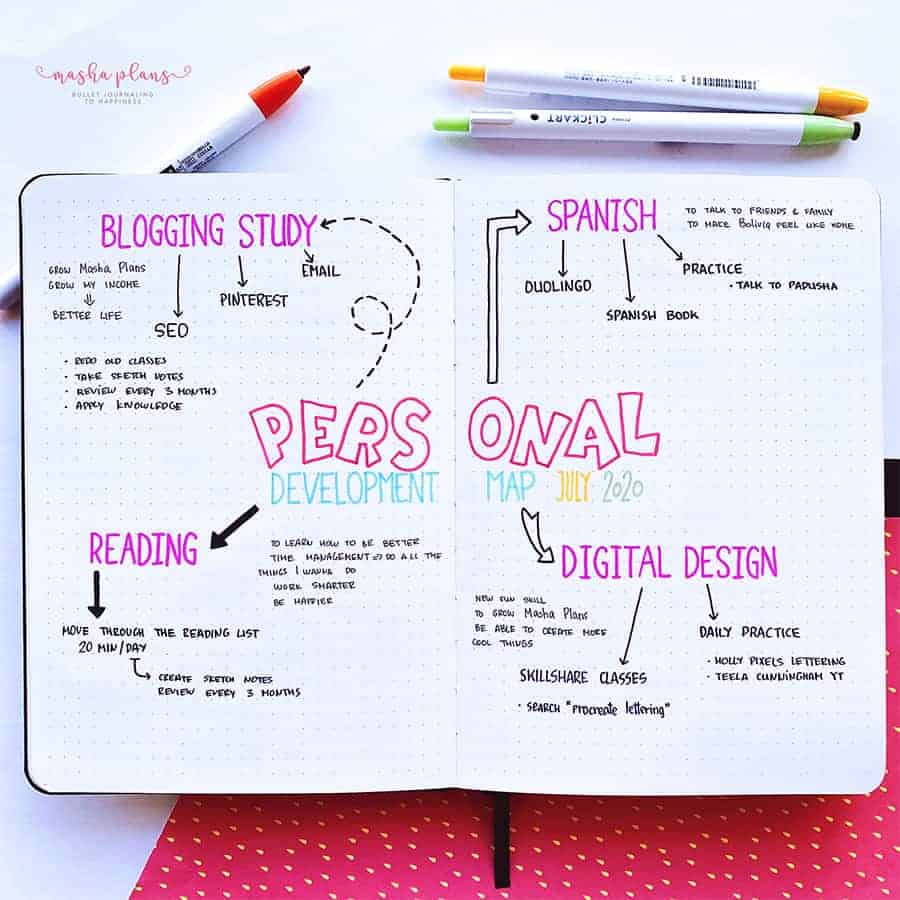




Bullet journaling has really saved my sanity when it comes to my day-to-day life and goals. I have no idea why I’ve never considered using it for work! Thanks so much for these killer ideas!!
So glad to hear you liked these ideas! Yeah it’s really amazing all the ways you can use your BuJo =)